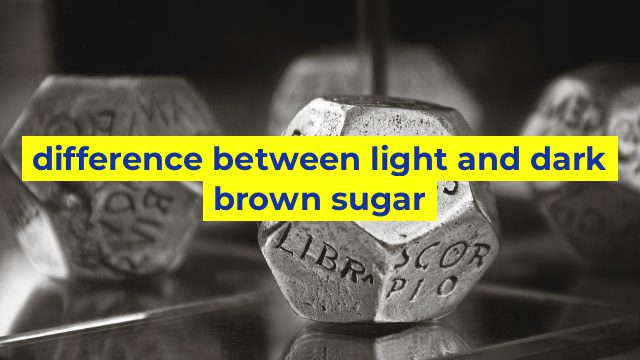The Differences between Light and Dark Brown Sugar: Which One to Choose?
Introduction
Are you confused about the difference between light and dark brown sugar? Can one be substituted for the other in recipes? These are common questions that arise when choosing which type of brown sugar to use in baking and cooking. Light and dark brown sugar may look similar, but they are different in several ways, and their uses can affect the taste, texture, and overall outcome of your dish.
What is Light Brown Sugar?
Light brown sugar is a type of sugar that is made by mixing molasses and granulated white sugar. It has a light amber color and a delicate flavor that is sweet with a hint of caramel. It contains around 3.5% molasses by weight, which gives it a softer texture and a mild flavor. This type of sugar is commonly used in recipes where the sweetness is the main flavor, such as in cakes, cookies, and pies.
What is Dark Brown Sugar?
Dark brown sugar is made by adding more molasses to granulated white sugar compared to light brown sugar. It has a deep brown color and a rich, robust flavor that is stronger and more complex than light brown sugar. It contains around 6.5% molasses by weight, which makes it stickier and denser than light brown sugar. Dark brown sugar is often used in recipes where the sweetness is mixed with other strong flavors, such as in gingerbread, BBQ sauces, and baked beans.
Substituting Light and Dark Brown Sugar
While it is generally safe to substitute light brown sugar for dark brown sugar and vice versa, it is essential to know that it can affect the outcome of your dish. Light brown sugar has a milder taste and softer texture, while dark brown sugar has a stronger flavor and denser texture. Therefore, if you substitute light brown sugar with dark brown sugar, it will result in a stronger and richer flavor, as well as a denser texture. If you substitute dark brown sugar with light brown sugar, you will get a milder flavor and softer texture, which can affect the overall taste of your dish.
Conclusion
In summary, light and dark brown sugar are two types of sugar that are commonly used in baking and cooking. Light brown sugar has a milder taste and softer texture, while dark brown sugar has a stronger flavor and denser texture. They can be substituted for each other in recipes, but it is essential to know that it can affect the outcome of your dish. Whether you choose light or dark brown sugar will depend on the recipe, the flavor profile you want to achieve, and personal preferences. Now that you know the difference between light and dark brown sugar, you can choose the one that is best for your needs and create delicious treats that everyone will love.
Table difference between light and dark brown sugar
| Light Brown Sugar | Dark Brown Sugar | |
|---|---|---|
| Taste | Subtle molasses flavor | Richer, deeper molasses flavor |
| Color | Lighter brown | Darker brown |
| Moisture Content | Lower moisture content | Higher moisture content |
| Texture | Slightly lighter and more granular | More dense and sticky |
| Uses | Used in recipes where a milder flavor is desired, such as cookies or cakes | Used in recipes where a richer flavor is desired, such as gingerbread or barbecue sauces |


